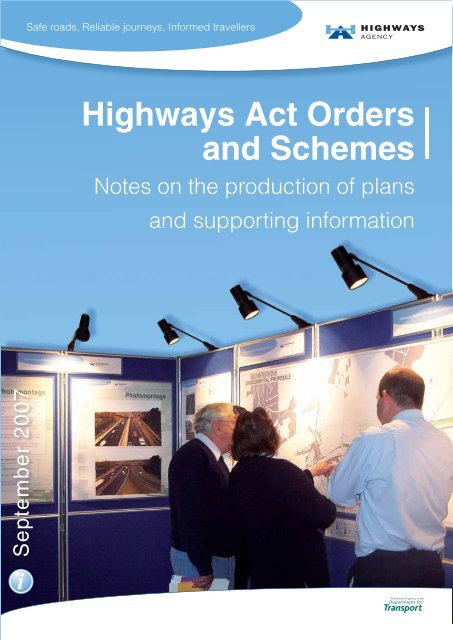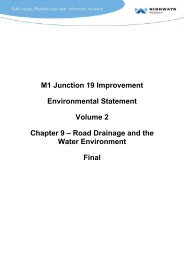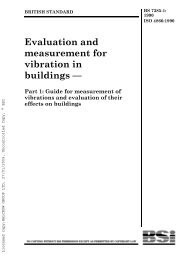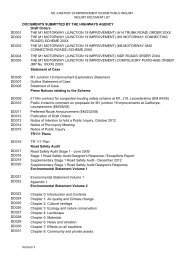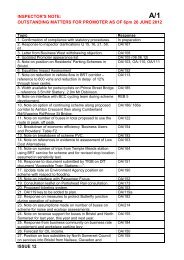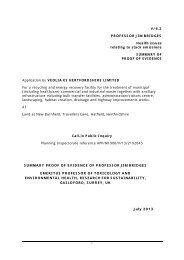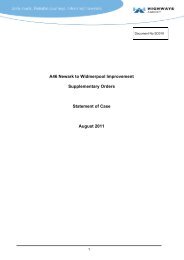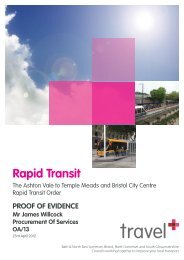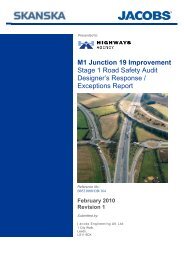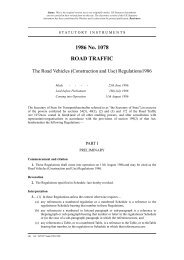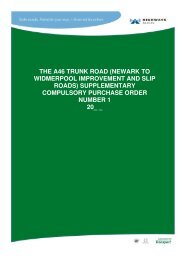Highways Act Orders and Schemes
Highways Act Orders and Schemes
Highways Act Orders and Schemes
You also want an ePaper? Increase the reach of your titles
YUMPU automatically turns print PDFs into web optimized ePapers that Google loves.
Safe roads, Reliable journeys, Informed travellers<br />
<strong>Highways</strong> <strong>Act</strong> <strong>Orders</strong><br />
<strong>and</strong> <strong>Schemes</strong><br />
Notes on the production of plans<br />
<strong>and</strong> supporting information<br />
September 2007<br />
i<br />
An Executive Agency of the
Index<br />
Introduction<br />
2<br />
Section A: Plans<br />
5<br />
1. General<br />
2. Line, detrunking <strong>and</strong> trunking <strong>Orders</strong> under Section<br />
10 of the <strong>Highways</strong> <strong>Act</strong> 1980<br />
3. <strong>Schemes</strong> under Section 16 of the <strong>Highways</strong> <strong>Act</strong> 1980<br />
4. Appropriation <strong>and</strong> Transfer <strong>Orders</strong> under Section 18<br />
of the <strong>Highways</strong> <strong>Act</strong> 1980<br />
5. Side Roads <strong>Orders</strong> (SRO) under Section 14 or 18<br />
of the <strong>Highways</strong> <strong>Act</strong> 1980 <strong>and</strong> stopping up of PMA<br />
under Section 124 of the <strong>Highways</strong> <strong>Act</strong> 1980<br />
6. Bridges over Navigable Waters <strong>and</strong> Diversion of<br />
Navigable Waters<br />
5<br />
8<br />
13<br />
16<br />
18<br />
24<br />
Section B: Supporting Information<br />
25
These notes provide guidance on the preferred method for<br />
preparing statutory Order plans <strong>and</strong> *Scheme plans, <strong>and</strong><br />
associated information.<br />
Introduction<br />
1. Statutory <strong>Orders</strong>/<strong>Schemes</strong>, with associated schedules <strong>and</strong> plans, are the primary<br />
documents which give legal powers, when made, to the Secretary of State to<br />
construct road improvement schemes. Each Order is accompanied by plans, which<br />
are required to provide clarity <strong>and</strong> remove ambiguity. The principal aim must be to<br />
ensure that <strong>Orders</strong> are legally sound <strong>and</strong> provide the powers necessary to deliver<br />
our schemes. The <strong>Orders</strong> should provide the greatest clarity to those affected by<br />
our proposals without compromising the legal position in any way.<br />
2. Once the need for <strong>Orders</strong> is identified the <strong>Highways</strong> Agency will ask the Consultant<br />
or the Contractors Design Team to prepare the basic documentation (ORD forms,<br />
plans <strong>and</strong> in some cases, schedules) to enable the <strong>Orders</strong> to be put together.<br />
3. When preparing <strong>Orders</strong>, our aim should be to make the minimum changes to<br />
the highway network needed to deliver the scheme, including any mitigation<br />
measures (which will be detailed in the Environmental Statement).<br />
Types of <strong>Orders</strong><br />
4. The following are the powers which are available for production of <strong>Orders</strong>. They<br />
dictate what may be included in any particular Order. Normally the Agency will<br />
identify which <strong>Orders</strong> are needed. However, if it becomes clear that additional<br />
<strong>Orders</strong> may be needed then this should be flagged up with the Project Manager.<br />
<strong>Orders</strong> under Section 10 of the <strong>Highways</strong> <strong>Act</strong> 1980<br />
5. Section 10 of the <strong>Highways</strong> <strong>Act</strong> creates a new Section of trunk road or trunks or<br />
detrunks an existing road. When a road is being detrunked the Order can include<br />
the future classification of the road.<br />
* The statutory term for a motorway is a special road, <strong>and</strong> an Order for a motorway is called a Scheme
<strong>Orders</strong> under Section 14 of the <strong>Highways</strong> <strong>Act</strong> 1980<br />
6. Section 14 of the <strong>Highways</strong> <strong>Act</strong> can allow the improvement of existing highway,<br />
the creation of new highway or the stopping up of existing highway. It is used to<br />
take powers to improve or to create new local authority highways or to stop up any<br />
highway including trunk road <strong>and</strong> is used in association with trunk road works. For<br />
motorway projects Section 18 powers are used. An Order under Section 14 can<br />
also include the creation of a temporary highway which will normally be maintained<br />
by the Agency rather than a local authority.<br />
7. An Order under Section 14 can also stop up or create a private means of access.<br />
Where only an access is affected an Order under Section 124 may be more<br />
appropriate.<br />
<strong>Schemes</strong> under Section 16 of the <strong>Highways</strong> <strong>Act</strong> 1980<br />
8. Section 16 of the <strong>Highways</strong> act allows for the creation of a new length of motorway<br />
for which the Agency will be the highway authority.<br />
<strong>Orders</strong> under Section 18 of the <strong>Highways</strong> <strong>Act</strong> 1980<br />
9. Section 18 of the <strong>Highways</strong> <strong>Act</strong> can allow the improvement of existing highway,<br />
the creation of new highway or the stopping up of existing highway. It is used to<br />
take powers to improve or to create new local authority highways or to stop up any<br />
highway including trunk road <strong>and</strong> is used in association with motorway projects.<br />
For trunk road projects Section 14 powers are used. An Order under Section<br />
18 can also include the creation of a temporary highway which will normally be<br />
maintained by the Agency rather than a local authority. An Order under Section 18<br />
can also stop up or create a private means of access.<br />
10. Section 18 can also allow the conversion of existing all purpose trunk road or a<br />
local authority road to a motorway. This Order would be separate from an Order<br />
under Section 18 altering highways or accesses.<br />
Section 106 of the <strong>Highways</strong> <strong>Act</strong> 1980<br />
11. Section 106 allows the construction of a bridge over or a tunnel under navigable<br />
waters. This can be done either by an Order under Section 106 or by including the<br />
proposal within an Order under Section 10, 14 or 18 or a Scheme under Section 16.
Section 108 of the <strong>Highways</strong> <strong>Act</strong> 1980<br />
12. Section 108 allows the diversion of navigable waters where this is necessary for<br />
the construction or improvement of any highway or the stopping up or creation of<br />
a means of access. The power can be included in an Order under Section 14 or<br />
Section 18.
Section A - Plans<br />
Style <strong>and</strong> format of Order plans vary depending on the type of Order <strong>and</strong> the size <strong>and</strong><br />
complexity of the scheme. The following guidance applies generally. Where a particular<br />
style is adopted by the project team it should be used consistently throughout.<br />
1. General to all Plans<br />
1.1 The plans should be on Ordnance Survey base <strong>and</strong> should include a Crown<br />
Copyright box. Crown Copyright should be recorded by the words<br />
“This plan is based upon Ordnance Survey material with the permission of Ordnance<br />
Survey on behalf of the controller of Her Majesty’s Stationery Office © Crown<br />
copyright. Unauthorised reproduction infringes Crown copyright <strong>and</strong> may lead to<br />
prosecution or civil proceedings. <strong>Highways</strong> Agency 100018928 20..”<br />
(insert current year)<br />
1.2 Plans should include a north arrow: there is no requirement that north should be<br />
at the top of the plan. Where there are a number of site plans/sheets to a plan, or a<br />
number of <strong>Orders</strong>, as far as possible, the plans should all have a similar orientation.<br />
1.3 Plans should normally include the name of the County, Borough or District, <strong>and</strong><br />
Parish or Town in whose area they lie. They should normally feature all road<br />
numbers, road names <strong>and</strong> all other names (eg place names, street names,<br />
house names & numbers etc) that are referred to in the <strong>Orders</strong>, Schedules <strong>and</strong><br />
Explanatory Statements. Where reference is made to a location some distance<br />
from the scheme, to avoid the need to enlarge the map so that it becomes difficult<br />
to h<strong>and</strong>le, the name should be marked at the edge of the plan with an arrow<br />
indicating the direction to that location.<br />
1.4 The following information should be included either on the plan or on the folio cover<br />
if a folio is included:<br />
• A scale both linear <strong>and</strong> in words. Guidance on recording the scale of<br />
insets is given below.<br />
• A box for the signature of the Order<br />
• The title. In addition, the sheets of the Order must be numbered <strong>and</strong>/or<br />
named. Guidance on this is given in the Sections below.<br />
• A key
1.5 When the preparation of draft Order plans is started, a plan register number<br />
should be requested for each Order <strong>and</strong> recorded on the plan or folio cover.<br />
The Special Road <strong>Schemes</strong> <strong>and</strong> <strong>Highways</strong> <strong>Orders</strong> (Procedure)<br />
Regulations 1993 SI 169<br />
1.6 These Regulations impose specific requirements on certain types of Order.<br />
The requirements, which are identified in the individual Sections below,<br />
should be complied with in all cases.<br />
Notes<br />
1.7 Notes can be included on plans to provide clarity. The notes for each type of<br />
plan are described in the individual Sections below.<br />
Use of Plan Folios<br />
1.8 Where there are two or more site plans/sheets for an Order these should be<br />
bound together in a plan folio. The folio cover should comprise the Order<br />
title, key, scale(s), signing block <strong>and</strong> plan registry number. For single sheet<br />
schemes this information is normally recorded on the plan <strong>and</strong> a folio sheet<br />
is unnecessary. The bound folio will normally be A4 in size <strong>and</strong> therefore, the<br />
folio cover should be A4 <strong>and</strong> the final Order plans need to be designed to fold<br />
to that size.<br />
Use of Key Plans <strong>and</strong> Location Plans<br />
1.9 When an Order plan contains more than one site plan/sheet, a Key Plan<br />
should be included showing the boundary of each of the site plans. The key<br />
plan should be at a scale appropriate to the size of the scheme <strong>and</strong> may be<br />
as small as 1:50,000. For very large schemes, the key plan may need to be<br />
shown on more than one sheet. Key plans should be marked KEY PLAN in the<br />
top or bottom right h<strong>and</strong> corner. Where there is more than one key plan sheet,<br />
each should be numbered (Key Plan 1 of 3, 2 of 3 etc).<br />
1.10 Occasionally, where only one site plan is needed a Location Plan will be<br />
included to show where the scheme is. This should follow a similar style to the<br />
key plan <strong>and</strong> should be labelled ‘Location Plan’. If there is no folio, the location<br />
plan should be included on the same sheet as the Order plan.
Scale of Plans<br />
1.11 The guidance below gives details of the scales applicable for particular types<br />
of Order. The choice of scale, particularly for major schemes, will normally be a<br />
compromise. Larger scale plans allow more information to be shown <strong>and</strong> are<br />
essential if a lot of complex detail needs to be conveyed. However, it is easier to<br />
gain an overall picture of the scheme at a smaller scale. Where the bulk of the<br />
proposals can be understood from a smaller scale plan, particular items which<br />
require more detail can be shown on insets. On major schemes, the smaller scale<br />
used for the Special Road Scheme or Trunk Road line Order acts as an overview<br />
with greater detail shown in the Side Roads Order. For smaller schemes, there are<br />
benefits in using the same scale for all the plans, including l<strong>and</strong> reference plans<br />
<strong>and</strong> Compulsory Purchase Order plans to allow them to be compared <strong>and</strong> read<br />
between easily.<br />
Use of Insets<br />
1.12 You can use insets to make plans less cumbersome <strong>and</strong> more importantly easier<br />
for users to underst<strong>and</strong>. Insets are more likely to be used on Side Roads Order<br />
plans. They can be used to show enlarged detail, <strong>and</strong> generally to provide<br />
greater clarity. Insets also enable different markings that coincide (eg, *PMA to<br />
be stopped up <strong>and</strong> route of new PMA, highway to be stopped <strong>and</strong> route of new<br />
or improved highway) to be shown separately.<br />
1.13 Insets should be labelled INSET. If there is more than one inset on a page, each<br />
inset should be labelled INSET A, INSET B etc moving from left to right across<br />
the plan. Care should be taken to ensure that the area outlined on the main plan<br />
corresponding to the inset (i) matches the area shown on the inset <strong>and</strong> (ii) is<br />
labelled SEE INSET A etc. Where all the insets are at the same scale as the main<br />
plan there is no need to include a separate scale for the insets. But if the insets<br />
are at a different scale, this should be shown within the inset.<br />
* PMA = private means of access
2. Line, Detrunking <strong>and</strong> Trunking <strong>Orders</strong> under Section<br />
10 of the <strong>Highways</strong> <strong>Act</strong><br />
Extent of Plans<br />
Requirement of Regulations<br />
2.1 The requirements of the Regulations are that the detail must be shown for at least<br />
67 metres to either side of the centre line of a new road shown in the Order. This<br />
includes 67 metres from any new connecting roads (i.e. slip roads). The base<br />
map must be Ordnance Survey based <strong>and</strong> show up-to-date detail.<br />
Scale<br />
Requirement of Regulations<br />
2.2 The Regulations require any Order plan for a new trunk road line to be at a scale<br />
of not less than 1:10,000.<br />
2.3 For a large scheme, 1:10,000 will normally be appropriate. For small schemes, a<br />
larger scale should be considered, eg 1:5,000 or 1:2,500.<br />
2.4 Trunking an existing non-trunk road <strong>and</strong> detrunking are not subject to the<br />
Regulations. As the highway is already in existence, a small scale plan may be<br />
appropriate but this should not be less than 1:50,000. If trunking/detrunking<br />
<strong>Orders</strong> are being published as part of a project including a new trunk road line<br />
or motorway scheme, the trunking <strong>and</strong> detrunking plans should be at the same<br />
scale as those for the new road.<br />
2.5 Where a small scale is used for the plan, <strong>and</strong> there are one or two items which<br />
need to be at a larger scale, for example termination points for the trunking or<br />
detrunking, this can be done by using insets.<br />
Markings<br />
Requirement of Regulations<br />
2.6 That the new centre line be shown by a solid black line not more than<br />
1.5 mm wide.
St<strong>and</strong>ard Key<br />
2.7 The following key conventions are used.<br />
Line Order<br />
Routes of new trunk road <strong>and</strong> slip roads<br />
Routes of other new highways<br />
(see scheme detail below)<br />
Route of new main trunk road on slip road Order<br />
Detrunking Order<br />
Road ceasing to be trunk road<br />
Trunking Order<br />
Road becoming trunk road<br />
Notes within the key<br />
2.8 The following note should be included on the plan folio cover with the key where<br />
new construction is being carried out,<br />
“This plan shows the centre line of the new Trunk Road(s) but not the width or<br />
construction detail.”<br />
Scheme detail<br />
2.9 For an Order showing a new road, little scheme detail should be added to the<br />
Ordnance base. Where a link road (new highway) is included in the Side Roads<br />
Order that will connect the scheme to the existing local network, this can also be<br />
shown diagrammatically by black <strong>and</strong> white dashes on the plan for a Section 10<br />
Order to make the Order easier to underst<strong>and</strong>. Where separate <strong>Orders</strong> are being<br />
prepared for the main line <strong>and</strong> the slip roads the slip roads should be marked by<br />
black <strong>and</strong> white dashes on the line Order plan. On the plan for the slip road Order<br />
the main line should be shown by two solid lines. The marking should be included<br />
in the key (see St<strong>and</strong>ard Key above).
Combining <strong>Orders</strong><br />
2.10 Normally the new trunk road <strong>and</strong> any slip roads will be included in the same line<br />
Order <strong>and</strong> should be shown on the same plan. However, for major projects there<br />
can be an advantage in showing these in separate <strong>Orders</strong>. If any of the proposed<br />
slip roads are challenged the line Order can proceed whilst consultation is carried<br />
out on modifications to the slip road Order. For a small scheme, the trunking,<br />
detrunking <strong>and</strong> the new line can be included in a single combined line <strong>and</strong><br />
detrunking Order on the same plan. However, for a larger project the detrunking<br />
will be in a separate Order for which separate plans will be required.<br />
Extent of new road marking<br />
2.11 Where a new section of trunk road is to be constructed, the line should start on<br />
the boundary of the existing trunk road at the point where the highway boundary<br />
of the new trunk road <strong>and</strong> the existing trunk road diverge (note it is the highway<br />
boundary not the carriageway boundary which is the relevant point).<br />
2.12 Where an existing trunk road is being upgraded partially on-line <strong>and</strong> partially<br />
on a new line, consideration should be given to how this can best be shown.<br />
The centre line of the road may be moved to one side <strong>and</strong> part of the existing<br />
highway closed without the need for this to be shown, although inclusion in the<br />
Order should be considered if the stopping up removes the bulk of the existing<br />
highway. Where most work is on-line with short lengths of new highway it is<br />
probably preferable to show only these short sections as a new line. However,<br />
where the new route predominates, consideration should be given to stopping up<br />
the existing road <strong>and</strong> showing the whole section as a new line. This is particularly<br />
the case where the on-line sections involve asymmetric widening with the existing<br />
road partly stopped up. One factor to be taken into account in that consideration<br />
is whether stopping up will result in significant extra l<strong>and</strong> acquisition.<br />
2.13 Connecting roads should be shown from the point where they diverge from the<br />
main line.<br />
Treatment of junctions<br />
2.14 Where the trunk road ends, the black line should continue as far as the highway<br />
boundary of the side road. Where it passes through a junction, it should be<br />
shown going round the roundabout or circulatory system.<br />
10
New grade-separated junctions<br />
2.15 The plan should show the full extent of the new trunk road line <strong>and</strong> slip roads as<br />
solid black lines, <strong>and</strong> to show the existing roundabout <strong>and</strong> connecting roads as<br />
new highways with black <strong>and</strong> white dashes.<br />
Numbering <strong>and</strong> lettering<br />
Line Order<br />
2.16 The start <strong>and</strong> end points of the new trunk road should be lettered A <strong>and</strong> B (<strong>and</strong><br />
the route <strong>and</strong> distance will be described in the line Order Schedule). Where<br />
there are a number of sections, the lettering will continue C - D, E - F etc, working<br />
across the plan from left to right. Slip roads will be numbered 1, 2 etc (<strong>and</strong> also<br />
described in the Line Order Schedule).<br />
Detrunking Order<br />
2.17 The route to be detrunked should be marked with broad black dashes <strong>and</strong><br />
lettered at either end of each section of detrunking (<strong>and</strong> the route <strong>and</strong> distance<br />
will be described in the detrunking Order Schedule). Care should be taken to<br />
identify the precise extent of the route to be detrunked to ensure that the whole<br />
route is included.<br />
2.18 Where a section of trunk road is to be stopped up there is no requirement to<br />
include it in the detrunking Order. On occasion, it may be appropriate to close a<br />
part width of a trunk road whilst detrunking the remainder, for example where one<br />
carriageway of an existing trunk road will be retained as a local road but the other<br />
is being stopped up.<br />
2.19 On the detrunking Order plan, the treatment is to show the existing roundabout to<br />
the point where it links to the local road network as ‘road ceasing to be trunk road’.<br />
Trunking Order<br />
2.20 Trunking is h<strong>and</strong>led in a similar way to detrunking. It is shown by an open ladder<br />
marking <strong>and</strong> lettered at each end of the section to be trunked.<br />
11
New bridges over Navigable Waters <strong>and</strong><br />
Diversion of Navigable Waters<br />
2.21 Guidance on plans for bridging navigable waters <strong>and</strong> for diversion of navigable<br />
waters is given in Section 6.<br />
12
3. <strong>Schemes</strong> under Section 16 of the <strong>Highways</strong> <strong>Act</strong><br />
Extent of Plans<br />
Requirement of Regulations<br />
3.1 The Regulations require that the detail must be shown for at least 67 metres<br />
to either side of the centre line of a new road shown in the Scheme plan. This<br />
includes 67 metres from any new connecting roads. The plan must be an up-todate<br />
Ordnance Survey base.<br />
Scale<br />
Requirement of Regulations<br />
3.2 The Regulations require any Scheme plan for a new special road to be at a scale<br />
of not less than 1:10,000.<br />
3.3 For a large scheme, 1:10,000 will normally be appropriate. For small schemes, a<br />
larger scale should be considered.<br />
Markings<br />
Requirement of Regulations<br />
3.4 That the new centre line of any new route included in the Scheme plan is shown<br />
by a solid black line not more than 1.5 mm wide.<br />
St<strong>and</strong>ard Key<br />
3.5 The following key conventions are used<br />
Line of new special road <strong>and</strong> slip roads<br />
Routes of other new highways<br />
(see scheme details below)<br />
Notes within Key<br />
3.6 The following note should be included in the key where new construction is being<br />
carried out.<br />
“This plan shows the centre line of the new special road(s) but does not show<br />
width or construction details”.<br />
13
Scheme Detail<br />
3.7 Little scheme detail should be added to the Ordnance Survey base. Where a<br />
link road is included in the Side Roads Order which will connect the Scheme<br />
to the existing local network, this can be shown by black <strong>and</strong> white dashes on<br />
the Scheme plan to make the Scheme easier to underst<strong>and</strong>. Where separate<br />
<strong>Schemes</strong> are being prepared for the main line <strong>and</strong> the connecting roads, the<br />
connecting roads should be marked by black <strong>and</strong> white dashes on the Scheme<br />
plan. On the plan for the Connecting Road plan, the main line should be shown<br />
by two solid lines. The markings should be included in the key. (See st<strong>and</strong>ard<br />
key above)<br />
Combining <strong>Orders</strong><br />
3.8 Normally the new motorway <strong>and</strong> any slip roads will be included in the same<br />
Scheme <strong>and</strong> should be shown on the same plan. However, for major projects<br />
there can be an advantage in showing these in separate schemes. If any of<br />
the proposed slip roads are challenged the main scheme can proceed whilst<br />
consultation is carried out on modifications to the connecting road scheme.<br />
Extent of new road marking<br />
3.9 Where a new section of motorway is to be constructed, the line should<br />
commence on the boundary of the existing motorway at a point where the<br />
highway boundary of the new <strong>and</strong> existing motorways diverge (note it is the<br />
highway not the carriageway boundary which is the relevant point).<br />
3.10 Where an existing motorway is being upgraded partially on-line <strong>and</strong> partially on<br />
a new line, consideration should be given to how this can best be shown. The<br />
centre line of the road may be moved to one side <strong>and</strong> part of the existing highway<br />
closed without the need for a new Scheme, although a Scheme should be<br />
considered if the stopping up removes the bulk of the existing highway. Where<br />
most work is on-line with short lengths of new highway it is probably preferable<br />
to show only these short sections as a new line. However, where the new route<br />
predominates, consideration should be given to stopping up the existing highway<br />
<strong>and</strong> showing the whole section as a new line. This is particularly the case where<br />
the on-line sections involve asymmetric widening with the existing road partly<br />
stopped up.<br />
3.11 Where an existing all purpose road is being upgraded to motorway, the Scheme<br />
plan should include the full route.<br />
14
3.12 Slip roads (connecting roads) should be shown from the point where they diverge<br />
from the main line. The starting point should be the highway boundary not the<br />
carriageway boundary.<br />
Treatment of junctions<br />
3.13 Where the motorway ends, the black line should continue as far as the point<br />
where the Motorway Regulations will end. This is normally the back of the verge<br />
of the side road. At motorway to motorway junctions, the links - including any<br />
circulatory junctions - should be treated as slip roads.<br />
Numbering <strong>and</strong> lettering<br />
3.14 The start <strong>and</strong> end points of the motorway should be lettered A <strong>and</strong> B. Where<br />
there are a number of Sections, the lettering will continue C - D, E - F etc. Slip<br />
roads will be numbered.<br />
New bridges over Navigable Waters <strong>and</strong><br />
Diversion of Navigable Waters<br />
3.15 Guidance on plans for bridging navigable waters <strong>and</strong> for diversion of navigable<br />
waters is given in Section 6.<br />
15
4. Appropriation <strong>and</strong> Transfer <strong>Orders</strong> under Section 18<br />
of the <strong>Highways</strong> <strong>Act</strong><br />
Scale<br />
Requirement of Regulations<br />
4.1 The Regulations require appropriation Order plans to be at a scale of not less<br />
than 1:2,500. This will normally be adequate.<br />
Markings<br />
St<strong>and</strong>ard Key<br />
4.2 The following key conventions are used<br />
Appropriation<br />
4.3 The markings should be applied separately to the main line of the proposed<br />
motorway <strong>and</strong> each slip road in recognition of the fact that these are separate<br />
highways. They should be applied to the full width of the highway between<br />
motorway fences.<br />
Scheme Details<br />
4.4 The scheme must be shown in sufficient detail to show the key laid across the full<br />
width of the highways.<br />
Extent of Marking<br />
4.5 The plan marking should extend to the full length of the road being appropriated<br />
or transferred. Slip roads should be shown by separate marking.<br />
16
4.6 Where a scheme is being carried out which is partially new highway <strong>and</strong> partially<br />
the appropriation of existing all purpose roads <strong>and</strong> the bulk of the route is<br />
new then the appropriation Order should be restricted to those short lengths<br />
of existing highway. However where most of the route is existing highway the<br />
appropriation should cover the whole route.<br />
Numbering <strong>and</strong> lettering<br />
4.7 The start <strong>and</strong> end points of the motorway should be lettered A <strong>and</strong> B. Where<br />
there are a number of Sections, the lettering will continue C - D, E - F etc. Slip<br />
roads should be numbered.<br />
17
5. Side Roads <strong>Orders</strong> (SRO) under Section 14 or 18 of<br />
the <strong>Highways</strong> <strong>Act</strong> <strong>and</strong> stopping up of PMA under<br />
Section 124 of the <strong>Highways</strong> <strong>Act</strong><br />
These notes also apply to plans being prepared for agreements<br />
under Section 4 of the <strong>Highways</strong> <strong>Act</strong><br />
5.1 Where there is a single plan this should carry the name of the Order. Where<br />
there are a number of plans, each site plan should be labelled SITE PLAN 1,<br />
SITE PLAN 2 etc, <strong>and</strong> will correspond to the appropriate Schedule in the SRO.<br />
Each site plan should have a site plan title corresponding to the Site Plan Title<br />
in the Schedule. This title should reflect the Section of the scheme included on<br />
that sheet taking its name from a significant junction, a building or community<br />
alongside the route or if necessary a geographical feature<br />
Scale<br />
Requirement of Regulations<br />
5.2 The Regulations require any SRO plan showing a new local highway to be at<br />
a scale of not less than 1:2,500. In addition, any Order under Section 18 of the<br />
<strong>Highways</strong> <strong>Act</strong> 1980 (which includes Motorway Side Roads <strong>Orders</strong>) must be at<br />
that scale.<br />
5.3 For a large scheme, this scale will probably be appropriate. For smaller schemes,<br />
1:1,250 may be more appropriate, particularly in an urban area. Occasionally,<br />
larger scale plans may be necessary. The need for this may be avoided by the<br />
effective use of insets.<br />
Markings<br />
Requirements of Regulations<br />
5.4 The Regulations specify that any new local highways (including footpaths,<br />
cycleways <strong>and</strong> bridleways) must be shown by a centre line surrounded by<br />
stipple.<br />
18
St<strong>and</strong>ard Key<br />
5.5 The following key conventions are used<br />
Route(s) of new highway(s)<br />
Centre Line<br />
Highway(s) to be improved<br />
Highway(s) to be stopped up<br />
Private means of access to be stopped up<br />
Route(s) of new means of private access<br />
Trunk road boundary (see para below)<br />
Side road boundary (see para below)<br />
Notes to be included with the key<br />
5.6 The following note should be included in the SRO plan folio -<br />
“This/these plan(s) does not/do not show widths or construction details”.<br />
Scheme Detail<br />
5.7 In addition to the Ordnance Survey information, site plans should show the<br />
proposed scheme including embankments <strong>and</strong> fence lines.<br />
Improvement of side roads (including footpaths,<br />
cycleways <strong>and</strong> bridleways)<br />
5.8 Improvement is the power to carry out works on a local authority highway where<br />
the Secretary of State has no general power of improvement. Note that it is not<br />
necessary to take powers under the Order where we have some specific power in<br />
legislation to work on a local authority road, for example to erect signs. Similarly it is<br />
inappropriate to take powers on trunk roads where general powers of improvement<br />
are available to the Secretary of State under Part V of the <strong>Highways</strong> <strong>Act</strong> 1980.<br />
19
5.9 Improvement is shown by cross hatching. The cross hatching should extend to<br />
the full width <strong>and</strong> length of the Section of highway where improvement works are<br />
to be carried out, including embankments <strong>and</strong> cutting slopes. Where the scheme<br />
will involve altering the highway boundary taking in l<strong>and</strong> beyond the existing<br />
highway boundary, the cross hatching should cover that additional area.<br />
Stopping up highways<br />
5.10 Stopping up (closing) highways is shown by broad diagonal black <strong>and</strong> white<br />
dashes. Stopping up can relate to a highway or to any area of highway. The plan<br />
should show the full length <strong>and</strong> width which is to be stopped up including any<br />
embankments or cutting slopes included in that section.<br />
5.11 Stopping up a section of highway would usually extinguish all highway rights<br />
permanently. Where some highway rights remain, it will normally be appropriate<br />
to stop up the existing highway <strong>and</strong> re-create a highway of a different class. For<br />
example, if an all purpose road is to become a pedestrian route the road should<br />
be stopped up completely <strong>and</strong> a new footpath created across an appropriate part<br />
of it. Where the intention is to retain existing rights but to restrict traffic movements,<br />
for example to ban right turns, a Traffic Regulation Order may be more appropriate.<br />
However, where the change will result in part of the highway being redundant then<br />
that area should be included as stopped up highway in the Side Roads Order.<br />
5.12 Where a proposed highway crosses existing highway, the existing highway<br />
should be stopped up between the fence lines of the new route. This will not<br />
prevent users from joining or leaving the new route at that point. If the intention is<br />
to ban such movements, then the stopping up should continue along the existing<br />
highway to a point at least one metre beyond the fence line of the new route.<br />
5.13 The ownership of stopped up highways will revert to the owner of the subsoil, who<br />
may not be the highway authority. Where an area of highway will be needed for the<br />
scheme <strong>and</strong> l<strong>and</strong> is not in the ownership of the Agency, particular consideration<br />
needs to be given to whether the rights should be stopped up. If the highway is<br />
stopped up <strong>and</strong> l<strong>and</strong> is needed, a note should be made to ensure it is included in<br />
the Compulsory Purchase Order (CPO).<br />
New highways<br />
5.14 This is shown by a centre line surrounded by stipple which is normally a st<strong>and</strong>ard<br />
width for the full length of the highway being provided. New highways include<br />
temporary highways <strong>and</strong> the term Temporary Highway should be included on the<br />
site plan <strong>and</strong> schedule.<br />
20
Lettering<br />
5.15 Each new highway should be identified by a letter placed in a circle, starting at<br />
A, <strong>and</strong> working across the site plan from left to right. Start again with letter A on<br />
each subsequent site plan.<br />
Stopping up <strong>and</strong> creation of private means of access (PMA)<br />
5.16 PMAs include both formal accesses to private properties <strong>and</strong> field gates which<br />
lead to no clear track or way. A distinction needs to be made between a right<br />
of way serving only the owner <strong>and</strong> occupier of l<strong>and</strong> onto which it leads from the<br />
highway <strong>and</strong> rights of way which are shared by several occupiers. Where it is a<br />
single owner /occupier the plan should show the stopping up <strong>and</strong> new access<br />
on the Side Roads Order plan. The new access can subsequently be omitted<br />
from the scheme or moved to another location to meet the l<strong>and</strong>owner’s wishes.<br />
However, where there are other interests taking access along the route the<br />
stopping up must appear in the Order. The position of the replacement access<br />
cannot be changed so easily so it must be chosen with care<br />
5.17 Stopping up PMAs is shown by a solid black line. Where the access serves only<br />
one interest, or the intention is simply to stop vehicles entering the highway,<br />
the marking need only be applied for a short distance back from the highway<br />
boundary, normally three metres. Where there is more than one user <strong>and</strong> access<br />
is being replaced elsewhere the marking must be shown across the full width of<br />
the access until it reaches the boundary of the last interest it serves.<br />
Lettering<br />
5.18 Each PMA should be lettered a, b, c working across the plan from left to right, the<br />
letter being placed in a circle. The letter should appear in the Schedule <strong>and</strong> on<br />
the ORD forms after the description of the route.<br />
.<br />
Creating new private means of access (PMA)<br />
5.19 A private means of access provides access to l<strong>and</strong> <strong>and</strong> property. Where access<br />
will be needed for maintenance of a structure or drainage, this would be provided<br />
by an easement <strong>and</strong> should not appear in the Side Roads Order.<br />
21
5.20 A new PMA is shown by narrow diagonal hatching. New PMAs should be a fixed<br />
width starting from the highway or carriageway boundary of the highway from which<br />
access is being taken. Where there is a need to provide visibility at a junction by<br />
setting back the fence line, the new access will be set back behind the revised<br />
fence line. However, it may be more readily understood if the new PMA is shown to<br />
the carriageway boundary. New PMAs should be numbered 1, 2 etc, working from<br />
left to right across the site plan, with the number placed in a circle. Each site plan<br />
will start again at 1, 2 etc.<br />
5.21 The PMA should be shown till it enters the last l<strong>and</strong>holding which it serves.<br />
Beyond that, any work will be accommodation work at the l<strong>and</strong>owner’s discretion.<br />
Combining different keys<br />
1. Where stopping up a highway or PMA coincides with a new or improved<br />
highway or new PMA.<br />
5.22 Normally, both the stopping up <strong>and</strong> the new or improved highway or new PMA will<br />
be shown on the main site plan. However, this can be difficult to do with clarity.<br />
Where a stopped up highway coincides with a new highway or PMA, ideally the<br />
markings for the new highway or PMA will be placed between the zebra hatching<br />
marking of the stopped up highway. If space does not allow clarity, show one set of<br />
markings on the main site plan <strong>and</strong> the other set of markings on an inset. Similarly,<br />
where an improved highway coincides with a stopped up PMA, the stopping up<br />
can be shown through the improvement marking. But if this is unclear, or where the<br />
stopping up of a PMA (a solid black line) prevents any other marking being seen,<br />
the new or improved highway or new PMA would be better shown in an inset.<br />
5.23 The aim (<strong>and</strong> challenge) for drafters is to show the information as clearly as<br />
possible. For example, where quite long lengths of local highways <strong>and</strong>/or PMAs<br />
are subject to stopping up, <strong>and</strong> are to be replaced with new <strong>and</strong>/or improved<br />
highways <strong>and</strong> new PMAs, it may be more helpful to show one set of markings on<br />
one big inset, <strong>and</strong> show the second set of markings on a similar sized second<br />
inset if possible, placing both insets side by side on the same site plan sheet.<br />
5.24 An alternative way to show stopping up is to show it only where no new or<br />
improved highway or PMA are being provided at the same locations. Where new<br />
or improved highway or PMA does coincide with stopping up, it is the improved/<br />
new highway or PMA that is shown rather than the stopping up. In effect, they<br />
are drawn over the stopping up so that the stopping up no longer shows. This<br />
style can provide clarity on what is ultimately intended <strong>and</strong> can be a useful way<br />
of presenting small <strong>and</strong> relatively simple schemes. But it does not show the full<br />
picture <strong>and</strong> would not be appropriate for complex junctions <strong>and</strong> major schemes.<br />
22
2. Where a new highway <strong>and</strong> PMA are to be provided over the same route<br />
5.25 Ideally a vehicular access should be separate from a new footpath or bridleway<br />
for the safety of users. However, this will not always be possible.<br />
5.26 New PMAs cannot be created over an existing public highway. Therefore if a PMA<br />
is to be provided along the route of an existing footpath or bridleway the highway<br />
must be stopped up, the PMA created <strong>and</strong> a new highway created <strong>and</strong> this must<br />
be reflected on the plan.<br />
5.27 The new access <strong>and</strong> new highway can be shown separately by showing one on<br />
the main plan <strong>and</strong> the other in an inset (or by using two insets if the main plans<br />
records a stopping up). However the preferred way of showing the markings is<br />
side by side. In either case a note on the plan <strong>and</strong> in the Schedule(s) to the Order<br />
indicates that the two are coincidental:<br />
“Along [part of] this route labelled ‘A’ a new private means of access labelled ‘1’<br />
(which will be subject to vehicular rights) is to be provided <strong>and</strong> subject thereto the<br />
footpath labelled ‘A’ is to be provided.”<br />
New bridges over Navigable Waters <strong>and</strong><br />
Diversion of Navigable Waters<br />
5.28 Guidance on plans for bridging navigable waters <strong>and</strong> for diversion of navigable<br />
waters is given in Section 6.<br />
23
6. Bridges over Navigable Waters <strong>and</strong> Diversion of<br />
Navigable Waters<br />
To Follow<br />
24
Section B - Supporting information<br />
ORD forms <strong>and</strong> plans (including l<strong>and</strong> reference plans) provide most of the information<br />
necessary for project teams to prepare draft <strong>Orders</strong>.<br />
1. Information required for production of the Order<br />
• Route descriptions need to be precise <strong>and</strong> unambiguous. The start <strong>and</strong> end<br />
points should be specific locations, e.g. from the eastern side of the junction<br />
with River Street, not from the junction with River Street<br />
• Distances for <strong>Orders</strong> under Section 10 or <strong>Schemes</strong> under Section 16<br />
should be to the nearest metre. For <strong>Orders</strong> under Section 14 or Section 18,<br />
distances should be given to the nearest 0.5 of a metre<br />
• As part of compiling the ORD forms, consultants should check with LHAs<br />
the classification <strong>and</strong> route number of all existing roads <strong>and</strong> highways<br />
affected by the proposals, <strong>and</strong> the classifications to be given to any new<br />
highways<br />
2. Publication, Publicity <strong>and</strong> Distribution<br />
The aim in publishing the proposals is to meet the requirements of the <strong>Highways</strong> <strong>Act</strong><br />
<strong>and</strong> to ensure that publicity can reach all parts of the communities affected (directly <strong>and</strong><br />
indirectly) by the proposed scheme. Newspapers that will carry our public notices must<br />
cover the whole area of the published scheme <strong>and</strong> the communities most closely affected<br />
by it. Every reasonable effort must be made to identify accurately all parties affected<br />
directly by the published proposals, as well as the wider community <strong>and</strong> any hard-to-reach<br />
groups to ensure they have the opportunity to comment on the proposed scheme.<br />
Newspapers<br />
Schedule 1 of the <strong>Highways</strong> <strong>Act</strong> 1980 requires that a public notice is published in at least<br />
one local newspaper <strong>and</strong> in the London Gazette. For smaller schemes two newspapers<br />
circulating in the area should be identified. For larger schemes care should be taken<br />
to ensure that local newspapers have been identified for all the Sections of the route. In<br />
addition, one newspaper – regional or national – should be identified which covers the<br />
whole route.<br />
25
Deposit Points – for <strong>Orders</strong> <strong>and</strong> Environmental Statements (ES)<br />
Deposit points for documents should be reasonably close to the scheme area, ideally<br />
within 5 miles. County <strong>and</strong>/or District/Borough Council offices are often a first port of call<br />
for deposit documents, but when the scheme area is more than 5 miles from any Council<br />
Offices, or where public transport to the Council Office is poor, deposit points should<br />
be identified locally. Libraries <strong>and</strong> Post Offices are often the best locations, but in small<br />
communities other venues may need to be considered.<br />
The choice of deposit points should take account of a number of factors. They would<br />
need to have sufficient space for the documents to be viewed. If the scheme should<br />
go to inquiry, the same deposit point may need to serve later on as a pre-inquiry library<br />
for the public, in which case it would need to accommodate a much larger volume of<br />
documents. Hours of opening (<strong>and</strong> early closing), transport links <strong>and</strong> disability access<br />
are all factors to be considered.<br />
On schemes with a contractor appointed, a local site office might have been established,<br />
which could be very suitable as a deposit point, <strong>and</strong> later on as a<br />
pre-inquiry library.<br />
Distribution<br />
There is a legal requirement to serve notice on those listed in the table opposite:-<br />
Consultees from this list should be set out first.<br />
The consultation list should be completed taking account of the guidance set out below.<br />
It is the normal practise to consult two further groups of people, those most closely<br />
affected by the scheme <strong>and</strong> representatives of the local community.<br />
A plan should be prepared which identifies the area where the scheme will have the<br />
greatest impact. This should include a b<strong>and</strong> at least 100 metres around the scheme<br />
Consideration should be given especially for larger schemes to extending this area.<br />
The list of consultees should include a list of owners <strong>and</strong> occupiers within that area.<br />
Members of Parliament <strong>and</strong> Members of the European Parliament together with parish <strong>and</strong><br />
community councils are consulted in all cases. Statutory undertakers are consulted for all<br />
<strong>Orders</strong> except trunking <strong>and</strong> detrunking. Their details should therefore be provided in all<br />
cases. A list should then be put together identifying other local groups <strong>and</strong> organisations.<br />
Particular care should be taken to identify representatives of minority or hard to reach groups.<br />
26
Requirements for different types of <strong>Orders</strong> or <strong>Schemes</strong><br />
Section 10 Section 14 Section 16<br />
Section 18<br />
Side Roads Order<br />
Every District, County<br />
or Unitary Council<br />
or National Park<br />
Board through whose<br />
area the existing or<br />
proposed road in the<br />
Order runs<br />
Every District, County<br />
or Unitary Council<br />
or National Park<br />
Board through whose<br />
area any highway or<br />
proposed highway<br />
included in the SRO<br />
runs or in whose area<br />
works are to be carried<br />
out<br />
Every District, County<br />
or Unitary Council or<br />
National Park Board<br />
through whose area<br />
the proposed Scheme<br />
runs<br />
Every District, County<br />
or Unitary Council or<br />
National Park Board<br />
in whose area works<br />
authorised by the SRO<br />
will be carried out<br />
The Council to <strong>and</strong><br />
from whom any<br />
highways in the SRO<br />
are to be transferred<br />
The Council to <strong>and</strong><br />
from whom any<br />
highways in the SRO<br />
are to be transferred<br />
The owner <strong>and</strong><br />
occupier of any<br />
premises whose<br />
access is stopped up<br />
in the SRO<br />
The owner <strong>and</strong><br />
occupier of any<br />
premises whose<br />
access is stopped up<br />
in the SRO<br />
The Parish Council,<br />
Parish Meeting or<br />
Community Council<br />
for every community<br />
or parish in whose<br />
area a highway is<br />
to be stopped up or<br />
diverted where there<br />
is no district or county<br />
council*<br />
The Parish Council,<br />
Parish Meeting or<br />
Community Council<br />
for every community<br />
or parish in whose<br />
area a highway is<br />
to be stopped up or<br />
diverted where there<br />
is no district or county<br />
council*<br />
All statutory<br />
undertakers with<br />
equipment in a<br />
highway to be stopped<br />
up by the SRO<br />
All statutory<br />
undertakers with<br />
equipment in a<br />
highway to be stopped<br />
up by the SRO<br />
And for any Order citing Section 106 or 108 of the <strong>Highways</strong> <strong>Act</strong> 1980,<br />
serve notice on the navigation authority for the waterway <strong>and</strong> the<br />
Environment Agency.<br />
*it is practise to serve notice on all parish councils <strong>and</strong> meetings where a highway is<br />
stopped up in a side roads Order whether or not there is a district or county council<br />
27
Publication Group Leeds N070127<br />
for <strong>Highways</strong> Agency Major Projects Division


